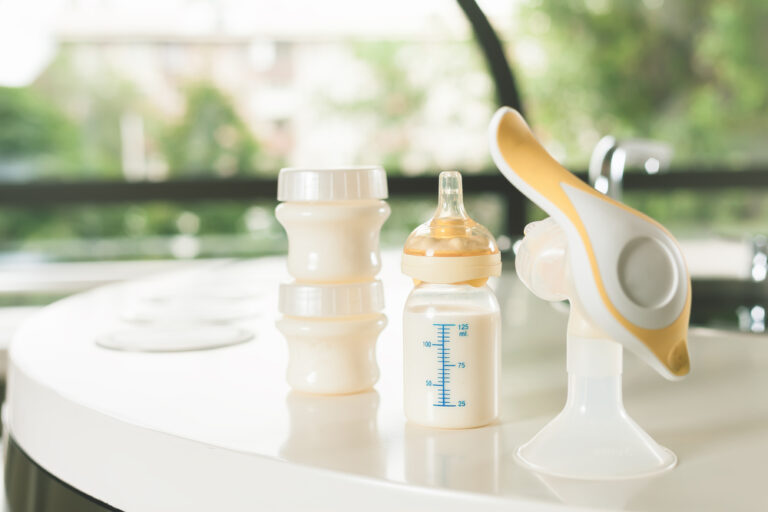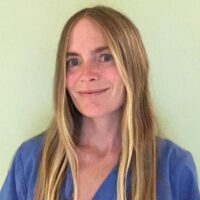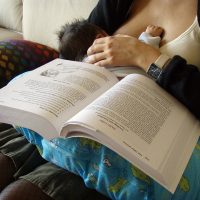To all the mammas who have decided to breastfeed, a breast pump is going to be your new best buddy. I’ve nursed 2 kids for nearly 2 years each, and am working on the 3rd, so I’m an old hand with a breast pump. I’ve worked full-time outside the home, worked part-time outside the home, worked from home, and totally stayed home full time. And through it all, my trusty everyday breast pump has been by my side.
Best Breast Pumps
Lansinoh Smartpump2.0 Double Electric Breast Pump is a quiet machine that you can use discreetly at work or while watching TV without waking up your baby, yet the Medela Advanced Breast Pump is quite a bit louder to operate, which makes it less discreet at work and risky of waking your sleeping infant.
Spectra S1 Plus Premier Rechargeable Electric Breast Pump
Let’s start with one of the best breast pumps and award-winning Spectra S1 Plus Premier Rechargeable Electric Breast Pump. This beloved breast pump uses Spectra’s natural nursing technology and is designed to make pumping as close to a baby nursing as possible. This electric breast pump gets the milk out. This pump offers adjustable suction strength and 2 different flange/breast shield sizes. There is even a massage mode to mimic a baby’s suckling, which helps get that milk flowing just like your baby would.
This is a closed system breast pump, which means that it’s more hygienic to use. It even comes with backflow protectors, which keep your breast milk out of bacteria’s way. The hospital-grade motor, which can achieve up to a 250mmHg suction rate, only operates at 45 decibels, which is pretty quiet for a breast pump. Other breast pump features include a night light for those late night pumping sessions and an auto timer with display. The rechargeable battery and the fact that the whole entire breast pump only weighs 3 pounds make it a fantastic option for moms who will be pumping on the go.
Like all other Spectra products, the S1 Electric Breast Pump features a 2-year motor warranty and 90-day accessory warranty, so you don’t have to worry about a part breaking and you being stuck with the bill.
All this being said, this breast pump does have some drawbacks. First off, accessories can be hard to find and can be very expensive. Plus, there’s a lot of pump parts, which makes cleaning pretty inconvenient. And, this breast pump does vibrate a little when in use. But the biggest drawback is the price, this pump is one of the more expensive ones on the market.
Spectra S2 Plus Premier Electric Breast Pump
The Spectra S2 Plus Premier Electric Breast Pump is also one of the best breast pumps and extremely comparable to the Spectra S1. The S2 is another compact breast pump, weighing in at only 2 and 1/2 pounds. This electric breast pump requires AC power to work, which does limit portability somewhat. It’s crazy quiet, working at only 45 decibels, and crazy efficient, getting up to 250 mmHg suction strength.
There are 12 different suction modes, including a massage mode, so you can adjust suction levels to get a natural flow of milk. There is an option of 2 different flanges/breast shields sizes to help you get the best fit. And thanks to the back flow protectors that are exclusive to Spectra breast pumps, breast milk stays within the closed system while being pumped so there is no worry of your milk being exposed to bacteria. This pump also features a night light that can be turned on for pumping in the dark and an auto-timer with a digital display screen so you can know exactly how long you’ve been pumping.
You get a two-year warranty on the Spectra S2 motor and a 90-day warranty on all Spectra accessories.
Some concerns with this breast pump are the tubing attachments, which come apart easily, and the duckbill valves. They like to fall into the milk while pumping and it’s a total pain. Also, the accessories, like the bottles and adapters, are less than great. Oh, and it’s not easy to clean with all those breast pump parts. It takes forever!
Want a more in-depth review? Check out our full review of the Spectra S2 electric breast pump.
Spectra S1 vs S2- what’s the difference?
You’ve read both breast pump reviews, so what’s the big difference between the S1 and the S2? The S1 has that fabulous rechargeable battery. See our in-depth breakdown of the Spectra S1 vs S2 breast pump for further comparison.
Medela Sonata Smart Double Electric Breast Pump with New Flex Breast Shields
The Medela Sonata Smart Double Electric Breast Pump is a smart breast pump that was actually inspired by the hospital-grade Medela Symphony breast pump. This pump features the Medela exclusive 2 phase expression technology. It also has that handy Medela letdown mode, which helps pump users extract up to 18% more milk compared to other pumps. You can also select from two different pumping rhythms to help collect breast milk more like your baby would.
This breast pump is small, it’s smart, and it’s quiet. Compared to other pumps, like the Spectra, the Sonata is much smaller. It’s also a smart breast pump, which means it connects to the Medela app so that you can operate this thing from your phone. This feature brings breast pumps into the 21st century, with a touchscreen display that is illuminated for easy operation day or night. And speaking of night, this is actually the quietest Medela breast pump, great for those middle-of-the-night pumping sessions and discreet enough to use while working at your desk. It pairs perfectly with the new and discreet Medela Safe & Dry nursing pads and comes with a rechargeable battery. You can take this breast pump anywhere.
The whole smart pump thing is great but does come with some issues. First of all, you can’t program anything into this breast pump, seems silly to me if it’s a smart pump! And the screen can be a little bit confusing. In final, the whole smart technology thing sets it up from problems requiring hard resets now and again to keep it working properly.
Another disappointment with this updated breast pump are the parts. Medela updated the size and structure of the parts they use and you can no longer use any of the older or alternate Medela Parts. Only parts made exclusively for the Sonata will function with this pump and the extra parts often desperately needed can be difficult and expensive to buy.
This breast pump is a favorite of working moms because it’s light, it’s small, and you can operate it easily. The tote bag that comes with it looks just like a stylish purse that you would carry anyway, as opposed to a large tote bag that says “here’s my giant breast pump”. For a somewhat high price, you get a good reliable breast pump that is geared toward working moms.
Ameda MYA Portable Hospital Strength Breast Pump
The Ameda MYA Portable breast pump is truly designed to travel with you and to deliver solid performance without the weight. In fact, this pump only weighs 8 ounces and you really don’t need a special bag to carry it in, just a medium-sized purse.
The pump unit itself is quite small and, despite it’s size, includes a rechargeable battery that lasts about 2 hours between charges. Some moms say they get 4 sessions out of it and others get 3 before needing to charge the batteries. A lot of moms with more than one brand of pump say that the MYA pumps faster than the other pumps they’ve tried, including the Spectra 1.
It has 10 different levels of suction that you’ll need to experiment with to find a level that you are comfortable with. It works in both single and dual-mode and has 5 different massage levels for the letdown phase. The rhythmic waveform it uses is meant to mimic a hospital-grade breast pump. The suction and massage settings are meant to work together to help get the milk out more like your baby would.
The other “portability” feature is its quiet operation. While it isn’t the quietest on this list (based on customer reports, not based on the manufacturer-supplied decibel level), it is in fact quieter than most. The Ameda MYA is a newer product and is very well-reviewed.
The pump itself is a closed system. Ameda prides itself on having an Airlock Protection barrier that helps keep the milk sealed and away from all tubing. The result is no buildup or condensation in the tubing. One of the few complaints is that the LED is very bright, so you may want to flip it on its face at night.
Lansinoh Manual Breast Pump
Whether you are pumping a lot or a little, it’s always a good idea to have a manual pump on hand. And Lansinoh Manual Breast Pump is one of the best. It’s a simple idea- the lever works to create suction that draws out the breast milk. And with each pump, the Lansinoh can get up to 250 mmHg of suction. That is just as much as a lot of electric breast pumps! The ergonomic handle means that your hands and arms won’t get so tired so fast, so you can do a full pumping session if need be.
There are two modes on this manual breast pump- stimulation, or letdown mode and expression mode. There are also two breast shield sizes, 25mm (regular) and 30mm (large) to help get a close and comfortable fit that will help to get the breast milk flowing and maximum collection efficiency.
The milk is collected in wide neck Lansinoh bottles that are BPA-free and all the parts are dishwasher safe. The Lansinoh manual breast pump does have a lot of parts, but the way that you assemble them is pretty intuitive, so it’s no more or less convenient than any other pump.
Like all breast pumps, this manual breast pump will work for some and not for others. As long as you keep all parts in tip-top shape, and keep them from warping in the dishwasher, this breast pump should last you a pretty long time with occasional use. Do yourself a favor and buy a manual breast pump. Use it for the intermittent missed feeding or as a backup for your electric one!
Bellababy Double Electric Breast Feeding Pumps
The Bellababy Double Electric Breast Feeding Pumps are a very popular and highly-ranked breast pump choice among moms, making it one of the best double breast pumps on the market. This pump includes 2 milk storage bag adapters, 10 storage bags, a high-definition display, and everything else you need to double pump.
Using a closed system, this hospital-grade double electric breast pump features 4 modes and 9 levels of suction including both massage and stimulation which prepare the breasts for pumping. The convenient wireless display shows the level, battery, and time, and gives moms the option to choose between massage mode, continuous suck mode, frequency conversion mode, and normal suck mode.
This breast pump is recommended for women who pump multiple times a day. The suction is really great, according to many reviews, but the noise is a little loud. For the quality, the Bellababy Double Electric Breast Feeding Pump is surprisingly inexpensive!
Haakaa Manual Breast Pump
Maybe you aren’t a working mom, but you still want a way to pump out some extra breast milk here and there without spending a ton of money. I have the breast pump for you! The Haaka Manual Breast Pump is a unique and a wonderful solution to simple pumping. This creative breast pump won a couple of parenting and innovation awards because of its awesomeness.

How it works is it creates natural suction with its design. It’s an empty bottle with a flanged top. When you squeeze the bottle and place the nipple inside the flange, you get natural suction. This can help to gently relieve engorgement or to collect letdown as you pump or feed from the other breast. It’s a lightweight and inexpensive manual breast pump option for mammas that need to pump for an occasional missed feeding or engorgement.
This inexpensive breast pump is made from all-natural and safe materials. It’s a soft, flexible, and high-quality food-grade silicone bottle that can hold up to 4 ounces.
As I said, the Haaka Manual Pump isn’t ideal for moms who are going to be returning to work. This will only work well for a mom who needs to pump small amounts occasionally. Since it only holds 4 ounces (more like 3.5) with the standard version, you can’t pump a lot at once. You can upgrade to a bigger one, but it does cost a bit more.
Another concern is that there is no lid or anything, so you have to be very careful not to spill. They do make a Haakaa breast pump with a lid and a Haakaa breast pump with a bottle stopper, but they’re a bit more expensive than the regular version. So you either have to be on your A-game and dump any milk you want to save directly into a milk saver bag or bottle, or pay the extra money for the model with the lid.
Other complaints that users have are that it may lose suction and drop off when it gets too heavy and full of milk and that because of the shape it isn’t easy to clean. However, it is dishwasher safe and can be sanitized in boiling water.
I love this simple option for collecting milk that would normally be wasted. This pump works without having to operate a frustrating and painful hand pump and instead uses natural suction and gravity to stimulate let down. This is definitely one of the best manual breast pumps out there. Give this unorthodox manual breast pump a try! You’ll probably like it more than a regular manual breast pump if you are exclusively breastfeeding.
Medela Pump In Style Advanced Double Electric Breast Pump
And now, on to one of the most popular breast pumps- the Medela Pump in Style Advanced (PISA). This is one of the best double electric breast pumps. It can be used to pump one or both sides. It’s designed for mammas who are going to be pumping a lot. It uses a 2 phase expression technology to mimic the way a baby sucks- harder at first, then more gently after letdown. You can adjust both the pump speed and suction to get the suction level just right to mimic your baby nursing. You can also use the letdown button and go into letdown mode to stimulate milk flow.
Why is PISA so popular? It’s covered by most insurance companies, a big bonus, and this pump is conveniently compatible with any bottles. It comes in different setup options- from the basic starter pack to the full kit with a cooler bag, breast milk collection bottles, and your choice of tote bag or backpack. This pump is easy to use, stylish and runs on both AC and battery power.
Oh, and there is a 1-year limited warranty on the pump and a 90-day warranty on all parts.
Some things to consider: this breast pump is loud and it is heavy. The pump and tote bag with a few empty bottles is going to be around 7 pounds, which can be quite heavy with a baby and other gear in tow. And the noise level is enough that you have to go to another room or risk waking your baby and you definitely can’t use the PISA incognito at your desk at work either!
The last consideration – it’s an open system breast pump. That means that breast milk can potentially get into the parts and cause bacterial growth, which can then taint the milk. I can tell you that I’ve personally used this pump for over 5 years now, and I have never had a problem with milk in the tubes. Just follow the instructions and clean this pump regularly, and it will be one of the best portable pumps for working mammas and stay-at-home mammas alike!
Want a full breakdown of all the Pump in Style’s pump features? Take a look at Experienced Mommy’s full review of the PISA.
Lansinoh Smart Pump 2.0 Double Electric Breast Pump
Most breastfeeding moms know and love the Lansinoh breast milk storage bags. So I was excited to take a look at a Lansinoh pump. The Lansinoh Smart Pump 2.0 Double Electric Breast Pump is Bluetooth compatible and syncs with Lansinoh’s app, Baby 2.0 to track pumping sessions, and more. It only weighs 3 pounds, so it’s a great breast pump for traveling with.
The breast pump itself has 3 pumping styles and 8 suction levels, allowing mom to get the most comfortable and efficient pumping experience. This pump even remembers your settings!
The hygienic closed system uses a diaphragm to keep milk from flowing back into the motor system. There are a lot of parts to the bottle and pump assembly, but they are easy to clean and put together. The backlit LCD display screen is easy to use at night without being obnoxiously bright and it clearly shows the different modes of operation, pumping time, and all other settings.
Overall, this is a good and very comfortable breast pump. It’s also one of the cheapest on the market and sometimes you get what you pay for. It offers lower suction than some of the other brands, like Medela and the suction works best if you only pump on one breast at a time defeating the purpose of buying a double pump! The Lansinoh Smart Pump 2.0 is very quiet though, which is convenient for pumping at work.
This is a decent choice with the lower suction level for moms that struggle with pumping soreness. But if you are a hardcore, exclusive pumper, this pump just won’t do the job.
Medela Freestyle Flex Breast Pump
With most traditional breast pumps, you have to hold the pump in place while you are using it. Not so with the Medela Freestyle Flex Breast Pump! This pump is one of the best hands-free breast pumps and small enough to fit in your pocket it is great for pumping at work. And it can even be used with a pumping bra for a hands-free experience!
The hands-free breast pump unit itself is super small and light. It weighs less than a pound and can be held around your wrist with the lanyard. The tubing then goes up into the Flex cups, which pump out milk while you do what you have to do. It has a built-in rechargeable battery that lasts 2 hours without a charge. A multifunctional interface displays the settings and battery life and offers moms count-up timer, delay start, and pause capabilities.
For those who exclusively pump, this may not be the best choice for you as some have said the suction is not great. Otherwise, moms love how discreet and portable the Medela Freestyle Flex Breast Pump is and that it connects via Bluetooth to the MyMedela app!
Willow Wearable Breast Pump
The Willow Wearable Breast Pump is an interesting breast pump because you can literally pump in any position! Seriously, you can pump while laying down and watching TV or while doing yoga. Crazy, I know! Anyway, this breast pump goes inside your bra and features 7 suction levels including a sensitivity setting for new moms. This pump also features Smart Suction Technology adjustable to your preference that can help you get more milk.
As you pump, milk flows into self-sealing hygienic bags for storage. Willow claims their breast pumps are spill-proof, so no need to worry about milk leaking out while you’re on the move. To help you learn how the Willow pump works, Willow provides an app, 1:1 coaching, and a sizing tool to make sure you purchase the correct sized flange. Each kit comes with 2 pumps, 2 flanges, 24 milk bags (4 oz each), 2 cleaning brushes, 1 charger, and a 1-year manufacturer warranty.
The iffy part about the Willow Wearable Breast Pump is the conflicting reviews from moms. Some moms absolutely love the Willow, even if the pieces are somewhat bulky, while others reports leakage and poor customer service. Regardless, Willow has been featured as a great breast pump choice by The Bump, babylist, and more!
Medela Symphony Breast Pump
In my humble opinion, the Medela Symphony Breast Pump is the best hospital grade breast pump. This thing is a milk collecting monster! Using Medela’s 2 phase expression technology, you get more milk out using the lower suction settings, settings of 50 to 250 mmHg. This hospital-grade breast pump begins in letdown mode stimulates milk flow to to help you collect more milk by. You can use this pump for pumping both breasts or for pumping one breast at a time. And the Symphony does all this while being extremely quiet and easy to use.
Unlike other Medela pumps, this one is a closed system. That’s what makes it a hospital-grade breast pump. It can be multi-user because the actual mechanism is totally separate from the collection kit. The breast pump parts are protected from overflow by a special Medela membrane and this means that this pump can safely be used by more than one person.
How the Symphony pump operates is really cool. It comes with a symphony 2.0 program card, which contains a little microchip that keeps track of all of the pumping program information. This means less work for you each time you plug it in to use because it will remember your personal settings, like your maximum comfort vacuum level, and all directions and settings are easy to read on the LCD display screen.
A big warning: this breast pump is extremely expensive. That’s because this is literally a commercial-grade breast pump (hence the 3-year warranty). I’ve personally used this in two different hospitals. Even though it costs an arm and a leg, it is one of the most efficient pumps out there. It is considered by some experts to be the best breast pump for low milk supply and for flat or inverted nipples.
Philips AVENT Comfort Electric Breast Pump
The Philips AVENT Comfort Electric Breast Pump has been designed purely for comfort. Everything from the tilted design to the silicone breast shields were created to increase milk production by increasing mother’s comfort. The breast shields, which come in a larger 25mm size, are more like cushions and are textured to feel warm against the skin with the unique petal design and the way that the breast shields attach to the bottle at an angle eliminate the need to lean forward while pumping.
The breast pump machine has 3 different settings: low, medium, and high. It also has a stimulation or letdown mode. Otherwise, there are no fancy bells or whistles with this breast pump. There’s not even a display screen of any kind. Just 5 buttons for turning on and adjusting suction. This lightweight 2-pound pump also features a closed system for hygienic pumping.
Many moms love that this comes with the AVENT natural bottles. These bottles make it so easy to go from pump to fridge to baby. Just change the top and use the BPA-free natural bottle nipples to give your baby breast milk when you can’t.
This is one of the best double electric breast pumps, but it doesn’t have a battery option, so you have to be able to plug it into a power source. The AVENT breast pump isn’t the strongest, and although this may be more comfortable, you have to hold the bottles, and shields in place since the suction is so low. It’s also really loud.
You are sure to love this pump if you have problems with sore nipples from pumping, but for those who will trade a tiny bit of discomfort for more efficiency, there are better pumps on the market for the same amount of money.
Want more information on the Philips AVENT Comfort pump? Experienced Mommy has done the research for you!
Spectra S2 vs Medela Pump in Style
Spectra S2 and the Pump in Style Advanced. Two of the most popular pumps. How do they stack up against each other? See our complete Spectra S2 vs Medela Pump in Style breakdown.
Types of Breast Pumps
As you’ve no doubt gathered, there are a few different kinds of breast pumps. There are 2 main breast pump types. Here’s a little about them, including their pros and cons.
Manual breast pumps. These breast pumps use suction created by a hand pump to stimulate the nipple through the breast shield and draw out milk. The hand pump can either be a lever attached to the collection bottles or the collection bottle itself.
- Pros: Quick to use, don’t depend on the power source, less expensive, easily portable, easy to clean
- Cons: Takes a lot of strength and endurance, can’t customize suction levels, takes longer to collect milk
BEST FOR OCCASIONAL PUMPING
Electric and battery-powered breast pumps. This used to be 2 separate categories, but now most electric pumps have a battery option, and vice versa. These breast pumps work by allowing a motor to create suction. The suction goes through the tubing and into the breast shields, where the milk then drops down into collection bottles.
- Pros: Collect milk quickly, collect more milk, allow for customization of sucking speed and strength, can get some models through insurance
- Cons: Dependent on electricity or expensive batteries, bulkier to travel with, can be noisy, harder to clean more parts, expensive
BEST FOR FREQUENT PUMPING
Within these 2 categories, there are both single breast pumps and double breast pumps.
- Single breast pumps can only extract milk from one breast at a time. Nearly every manual pump is a single pump, and most popular pumps come in a single pump option.
- Double breast pumps allow you to extract milk from both breasts at the same time. Double electric breast pumps are good options because not only do they save time, but the simultaneous breast stimulation a double pump offers has been proven to actually enhance milk supply. Many can even be converted to a single breast pump if needed.
Finally, breast pumps can be categorized as an open system or closed system.
- Open system breast pumps are designed so that the milk could go into tubing that interacts with the motor. Most often, this occurs as the result of pumping too much, creating an overflow into these parts. This is a big deal because breast milk is a bodily fluid and can transmit bacteria and viruses. Because of this design, opened system pumps are single-user and it is against medical recommendations to share even after cleaning.
- Closed system breast pumps are designed with barriers or filters that prevent the milk from entering the tubing and motor. The milk goes straight from the breast shield and into the collection container. Rental pumps are hospital-grade pumps and are closed systems. As long as the shields and tubing are keep separate, it’s okay to share the motor portion of a closed system breast pump.
Breast Pumps Compared
The table below compares only the recommended products on this page. A low or high Price means it is low or high compared to the other products listed.
The Popularity Score reflects how often readers click on and buy the product. The Quality Score is our assessment of the overall performance and satisfaction with
the product compared to others in the table.Medela Symphony Breast Pump 9.3 8.8 1,984.47 Medela Sonata Smart Double Electric Breast Pump with New Flex Breast Shields 9.4 9.0 381.94 Willow Wearable Breast Pump 9.2 7.4 313.00 Spectra S1 Plus Premier Rechargeable Electric Breast Pump 9.9 9.4 198.00 Lansinoh Smart Pump 2.0 Double Electric Breast Pump 7.9 9.0 188.57 Spectra S2 Plus Premier Electric Breast Pump 9.8 9.2 172.00 Medela Pump In Style Advanced Double Electric Breast Pump 9.7 - 129.99 Bellababy Double Electric Breast Feeding Pumps 3.9 8.6 59.00 Types of Breast Pumps 9.9 9.0 28.70 Lansinoh Manual Breast Pump 9.9 9.0 23.48 Medela Freestyle Flex Breast Pump 9.9 8.8 18.99 Haakaa Manual Breast Pump 9.9 9.2 12.94 Philips AVENT Comfort Electric Breast Pump 5.7 9.2 - Ameda MYA Portable Hospital Strength Breast Pump 8.5 8.8 -
How to Choose a Breast Pump
Now that you know the types of breast pumps, you’ll want to know what else to look for when choosing a breast pump. Here are some of the most important categories to consider. Look for these breast pump features when shopping:
- Suction. How strong is it? Hospital-grade? Personal use? Many breast pump manufacturers will give you a number, measured in mmHg, that tells you how strong the suction is. Many pumps feature adjustable suction to help you comfortably draw out breast milk.
- Expression modes. Many breast pumps now have a letdown mode as well as an expression mode. This really helps to get the milk flowing, and it can help you get a lot more milk during each pumping session.
- Battery power. Does the breast pump have a battery-powered option? Does it come with, or do you have to buy a battery pack separately? Also, how many and what type of batteries does it take? Replacing 6 batteries every 2 weeks can get expensive. Reading through the reviews can give you a realistic idea of how long the batteries last.
- Price. Breast pumps can run anywhere from a few bucks to several thousand. In looking at what you can afford, keep in mind the number of features, the warranty, and the suction strength. Don’t pay more for a pump than you have to. There are many good and affordable breast pumps on the market. Your insurance company may even help pay for it, so don’t let price have too much of an influence on your decision before checking with yours.
- Warranty. Nearly every breast pump sold on the market today will have a warranty. Keep a special eye on this number, because it will probably tell you a lot about the quality of the motor and the accessories. The longer the warranty, usually the more sturdy and reliable the motor is. Most good options have a 2 year or longer warranty.
- Display and programming. You can find breast pumps that have no displays or high-tech digital screen displays. LCD screens are the most popular choice. Along with the screen, check for programming options. Some pumps will have the option to save your favorite pumping settings for repeated success.
- Portability. These days, nearly all breast pumps claim that you can travel with them. But how functional is it really? How much does the pump itself weigh? That’s going to be the biggest determining factor for portability. Look at other things though, like whether or not the pump comes with the tote bag, how long the tubing is, and also if it can be charged in your car or run for a long time on batteries.
- Accessories. Some breast pumps come with just the motor itself, while some will come with full tubing and breast milk collection kits, as well as other accessories, like tote bags, milk collection bottles, and even nipples for feeding. This is important because some brands will charge a lot of money to get the right accessories to go with your pump after the fact. Look for starter kits, which are usually a pretty good deal and come with everything you need.
- Cleaning. Usually, the more parts that are included, the harder the cleaning. Also, open system breast pumps are notoriously harder to clean and you are often going to have to disconnect the tubing and totally sanitize it. Also, check to see if the flanges, collection bottles, and other parts are dishwasher safe. This will make your life a whole lot easier!
- Noise level. When and where you pump will determine the noise level that is acceptable. If you do a lot of pumping at night while your baby is trying to sleep, then you want to find a breast pump that is whisper quiet. Also, if you are trying to discreetly pump while at work, you want to find a smaller and quieter breast pump. Otherwise, noise might not be a huge factor for you. In any case, it’s nice to have a pump that you don’t have to shout over every time you use it.
- Breast milk volume. The last consideration is how much breast milk you will be pumping at a time. If you produce more than 3 or 4-ounces per pumping session, you’ll want to make sure that your breast pump can accommodate larger collection bottles. Some pumps may only work well with 2 or 3-ounce collection bottles, while some pumps can take collection bottles that go up to 10 ounces.
How to Use a Breast Pump
You’ve done the research and you’ve got yourself a good breast pump. Now what? Using a breast pump can be intimidating at first, but it’s a pretty intuitive process that gets easier each time you do it.
Get dressed. Before you even think about actually pumping, you need to make sure that you are dressed for the occasion. Any nursing top or bra will work just fine. If you are going to be pumping in private, you can wear pretty much anything. Just avoid shirts with a lot of extra material, as they can just get in the way. If you are pumping in public and prefer to be covered up, make sure that your shirt exposes just the breast. If not, you can grab a pumping/ breastfeeding cover or blanket to use.
Get comfy. If you have an electric breast pump, find a wall outlet that’s close by. Most electric breast pumps have shorter cords, so you may have to get an extension cord. Aim for a spot that is comfortable. You’ll want a couch or chair that has good back support so that you can sit up straight. You may find, leaning forward slightly, that gravity will help you collect more milk, so make sure you have enough space in front of you.
Get clean. Once you’ve scoped out your spot, make sure that your hands are clean. Wash and dry your hands well, and make sure that all of your breast pump parts are clean and ready to go.
Get attached. Before using the breast pump, place your nipple in the middle of the breast shield opening. You want to make sure that they are centered correctly so that you don’t hurt yourself! Moms who are new to pumping find it much easier to center the shield without the bottles attached. Once you’ve got the breast shields or flanges on correctly, attach the collection bottles. Make sure that all of the parts and tubing are connected and you are ready to go. Don’t forget that if you are going to be using your double electric breast pump as a single pump, you must blocked off the unused side or it won’t work.
Get pumping! Now it’s go-time! Turn on the machine and begin pumping. Don’t get discouraged if nothing comes out right away. It can take up to 2 minutes to get the milk flowing. If your breast pump has a stimulation or letdown mode, use that first. Then, switch into expression modes to collect as much milk as possible. If your pump doesn’t have any fancy settings, then manually try to adjust the pump speed and suction at the beginning. This will mimic the frantic motions of a hungry baby suckling until letdown. Once everything is going well, adjust to a comfortable speed, and relax until you are done!
Get cleaned up. When your breasts are emptied and milk is no longer being expressed, turn off the breast pump. Remove the breast shields carefully by inserting a finger gently under the side to break the seal. Watch out for drips! Unscrew the breast shields/flanges from the collection bottles and put lids on them. Store them properly remembering the CDC’s rule of fours: breast milk is okay for four hours at room temperature and four days in the fridge.
Cleaning Your Breast Pump and Parts
Beyond using the breast pump, you’ll need to become a pro at cleaning it. That will help to prevent any and all dangerous germs from getting into contact with your “liquid gold.” Proper cleaning will also help get rid of that build-up that some nipple creams can cause on your breast pump parts. You have 3 basic options when it comes to cleaning your breast pump.
1. Handwashing
Each breast pump has its own parts that will need cleaning. Handwashing is a simple way to ensure that your parts are always clean. In general, here’s how the FDA recommends that you wash your breast pump parts.
- Start by disassembling the pump and rinsing the breast pump parts as soon as you can after each pumping session
- Then, when you are able, washing the breast pump parts in warm soapy water and rinse well with very warm/hot water
- Place clean pieces on a clean towel or drying rack to air dry
- Assemble parts only when they are completely dry
2. Dishwashing
This method is so much faster and more convenient than handwashing. Many breast pump parts, like collection bottles and breast shields, can be cleaned and sanitized in the top rack of the dishwasher. A tip from me: use an unscented and all-natural dishwasher detergent to avoid the weird chalky buildup and permanent floral scent that some plastics get from regular scented dishwashing detergent. The biggest drawback to this method is that you have to have extra collection bottles and breast shields unless you want to be running the dishwasher between all your pumping sessions.
3. Microwave Sanitizing
This method is my personal favorite. It’s fast, it’s easy, and it kills germs. You can purchase special microwave bags that use the power of steam to clean your pump parts. Just rinse your breast pump parts thoroughly immediately after pumping, add some water to the bag, and nuke it all for a few minutes. Drain any excess water and open the bag so the parts can air dry. This is the best method for working moms who might not have 10 minutes or a clean sink to use to wash stuff.
Keep in mind when cleaning your breast pump that a combination of the above methods can work really well. For example, I would microwave clean my parts while at work, then I’d come home at night and either hand wash or dish wash my pump pieces for the next day. That way, I knew that they were always clean and ready to go.
Once your breast pump parts are clean, be careful to keep them that way. If you can help it, don’t touch the inside of any pump accessories that will come into immediate contact with the breast milk. Store the pump pieces in a clean place where they won’t get dirt or lint on them. If pump parts have been in storage for a long time, give them a nice cleaning before using them again.
FAQs – Breast Pumps
What does the term “hospital grade” breast pump mean?
This is a marketing term. It’s not a term regulated or recognized by the FDA, so any seller can say that their breast pump is hospital grade. Hospital-grade pumps are designed to work differently than personal use pumps. Namely, they are stronger, which helps to initiate and maintain the breast milk supply. That’s why hospital-grade breast pumps are the best breast pump for low supply. They are also designed to be used constantly and by more than one user. If you see a pump with the label “hospital grade,” be sure that it actually is before purchasing.
Does breast shield/ flange size really matter?
Yes! It might seem silly, but the size of the breast shield/flange can make a big difference. Correct flange size will equal better suction on your breast pump and more milk production for you. It will also make the whole experience much less painful. Keep in mind that a breast shield that previously worked for you may not work for another breastfeeding journey, since nipple size and shape can change with each child. Medela has a great guide for what size shield you will need. Some breast pumps are only compatible with certain sizes, and that may or may not work for you, so be sure to check what size breast shield comes with the pump that you choose. Also, look for inserts that you can place inside a breast shield to make it fit better.
Side note: breast flanges for breast pumps and nipple shields for breastfeeding are sized differently.
What are the best breast pump accessories?
Every person will need something different to go with their breast pump. Here are my top 10 things you’ll want and need for your pumping sessions:
- A hands-free pumping bra
- Milk storage bags
- Milk collection bottles in different sizes
- A microwave sanitation bag for your pump parts
- Small brushes and drying rack for cleaning
- A tote bag or backpack to carry the pump in
- Extra parts, like membranes and tubing
- A couple of backup breast shields in different sizes
- A cooler bag for your pumped milk
- Extra batteries or an extra charger (especially a USB or car charger!)
Can I buy a used breast pump?
Technically, yes, you can buy a used breast pump. But only if it’s a closed system breast pump that is intended for more than one user. The FDA warns against buying a used pump since you can never be sure if it was cleaned or used properly. The big worry with improperly used pumps is that there could be bacteria or mold hiding in the breast pump that could make your or your baby sick. Breast milk can also transmit certain diseases, and no one wants to risk that! The manufacturer won’t honor the warranty if you aren’t the original purchaser of the pump, so you won’t get much help if something goes wrong. Overall, I’d say that unless you know the original user very, very well (like your sister for example), stay away from used breast pumps.
What’s the best breast pump for twins?
Breastfeeding twins is not for the faint-hearted! Mammas of twins need all the help they can get from their pump. Look for durable breast pumps that are “hospital grade.” These are more expensive, but they will last through pumping many times a day. I would recommend either the Medela Symphony or the Spectra S1 or S2 for twins. They are all durable and have strong, adjustable suction. These three breast pumps are also good options because they have such amazing and long warranties, which come in handy when you are doing extra pumping!
How can I pump more breast milk?
I wish there were a magic answer to this question. Each mom makes milk differently. Here is some generally good advice that can help you increase your milk-making quota.
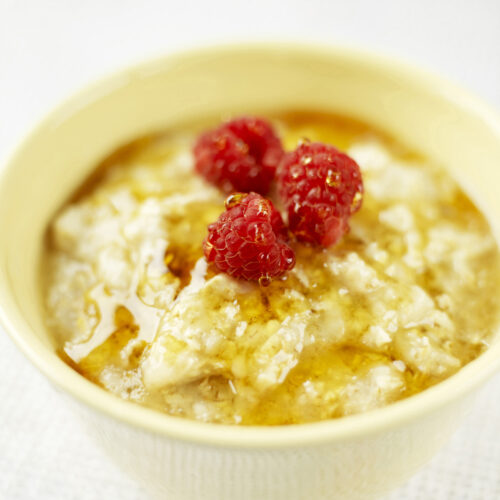
- Relax! Don’t look at the bottle and how much is being pumped. Distract yourself from the numbers.
- Think about your baby. This is proven to get that milk going. Grab your phone and watch videos or look at pictures of your little angel while you pump.
- Eat a good diet. There are certain foods that might help with milk production. Overall, just be sure that you are getting plenty of water and enough calories.
- Try galactagogues. Many moms find that they can get an extra ounce or two from trying certain supplements or herbs.
- Mimic your baby’s schedule. Breast milk is on a supply and demand routine, so try to pump when your baby eats. Pumping as often as baby eats helps you keep up with their demand so that you can have enough milk as they need.
- Give yourself enough time. Pumping for 5 minutes obviously won’t be as fruitful as pumping for 10 minutes. If you can help it, don’t look at the clock and instead look at your milk production as a timing cue. Most pumping sessions take between 10 and 20 minutes to get full let down and collection.
How often should I pump?
Your baby’s age will be the biggest determinant for how long you should pump. For example, a 2-month-old baby will eat about every 2 hours, while a six-month-old baby eats every 3 hours. Like I mentioned earlier, the most successful pumping sessions are those that mimic your baby’s eating schedule. Add in a couple of extra pumping sessions to keep your supply going strong and to get some extra as a backup in case you are separated from your baby for longer than planned. Here is a fantastic sample schedule from the experts at lactationmatters.org:
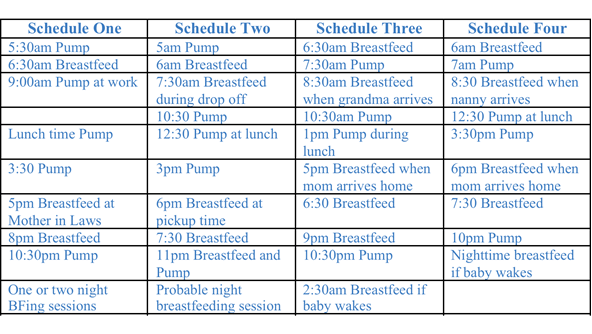
Bonus: Benefits of Breastfeeding (and my secret weapon)
 Maybe you’re on the fence. Maybe you want a good reason to breastfeed. Although I could give you 141 Reasons to Breastfeed, I’ll make it brief. Here’s why breastfeeding is good in a nutshell – it’s the perfect feeding system for your baby. Breast milk is specifically created to nourish a growing baby by having just the right amounts of fat, protein, and nutrients.
Maybe you’re on the fence. Maybe you want a good reason to breastfeed. Although I could give you 141 Reasons to Breastfeed, I’ll make it brief. Here’s why breastfeeding is good in a nutshell – it’s the perfect feeding system for your baby. Breast milk is specifically created to nourish a growing baby by having just the right amounts of fat, protein, and nutrients.
The American Academy of Pediatrics and the World Health Organization recommend breastfeeding over bottle feeding whenever possible. Why? It is better for the baby, and it’s really great for mommy, too. Some research shows that breastfed kids are smarter, healthier, and have better bonds with their mothers. My favorite part of breastfeeding is that it is said to lower the risk of SIDS. Mothers who breastfeed can reduce their risk of certain cancers and can lose baby weight quicker. Plus, it’s cheap, nearly free, and you’ll save time by not having to prepare and clean up bottles of formula. Although if you want the option to also bottlefeed, we have a great list of bottles for breastfeeding here.
I won’t lie, breastfeeding is hard. And there are times I wonder, is this really all that great? There are a lot of challenges to breastfeeding, but the science backing the benefits is mounting. At the end of the day, do what feels right for you and your baby. Each child is different, and each feeding journey will be different too.
But you know all this. Moms are notorious for researching all their parenting decisions. I won’t spend a lot of words trying to convince you to breastfeed. What I will do is tell you the most indispensable breastfeeding help I ever received.
My secret weapon — the lactation consultant.
Lactation consultants are amazing. With their help, more moms are breastfeeding successfully. A lactation consultant is a breast expert that can help you with all your breastfeeding concerns:
- Latching position and techniques
- Low supply or oversupply
- Pumping advice and breast pump rental
- Nursing patterns
- Painful nursing, especially nipple pain and problems
- Nursing through sickness (yours or baby’s)
- Even weaning!
They are especially invaluable if you have a challenging breastfeeding situation, like nursing a baby with special needs or nursing twins or multiples.
Just one visit is all it will take for you to love lactation consultants. If it weren’t for them, I would not have breastfed my two kids. They helped me to tackle issues with painful engorgement, oversupply, and a tongue and lip tie on one of my babies. I even got help making up a breastfeeding and pumping game plan for when I went back to work. I didn’t know how to do it on my own, so their information was invaluable. Many lactation consultants don’t mind if you call or text them after a visit, so you can contact them any time as issues arise.
For best results, look for a lactation consultant who has the letters IBCLC after their name. It means that they are certified by the International Board of Certified Lactation Consultants. In layman’s terms, it means that they know their stuff and they can prove it. You can find one through your local hospital or women’s clinic, or you can search for one online. Most lactation consultants are free, but some may charge a small fee for an in-home visit.
Please believe me when I say that lactation consultants can help you! You will be so thankful that you’ve tapped into their amazing amount of expertise. It’s the secret weapon to breastfeeding success.
